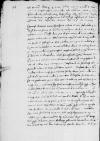List #1435
[Ioannes DANTISCUS] do [Mikołaj GRABIA?]Löbau (Lubawa), 1536-04-07
Regest polski: Dantyszek tłumaczy się, że nie odpowiedział na kilka listów Adresata. Czekał na okazję, by mógł posłać kogoś ze swoich ludzi z odpowiedziami na dwór. Teraz taka okazja się nadarza i Dantyszek nie może pozwolić, by jego posłaniec wyruszył bez listu do Adresata. Dantyszek życzy Adresatowi dużo szczęścia i dziękuje mu za powiadomienie o nowych sprawach na dworze. Prosi Adresata, by czynił to częściej, za co będzie zobowiązany i wdzięczny. Poza tym odpisał królowej w takim liście, jaki mu Adresat własnoręcznie ostatnio naszkicował, kiedy królowa domagała się od Dantyszka, żeby nie rozszerzał ugody z Kostką poza granice zgodne z jej wolą. Zresztą nic nigdy nie było i nie będzie dla Dantyszka łatwiejsze do spełnienia, niż ten rozkaz królowej. Nie wie tylko, w jaki sposób powzięto o nim na dworze taką opinię, jakoby nie było odeń nikogo bardziej chętnego do siania i podsycania niezgody. Prosi nieustannie Boga o pokój, którego zawsze był miłośnikiem. Jednak nie może uniknąć oszczerstw, podobnie jak wielu świętych i dobrych mężów czy nawet sam Chrystus, który osądzi wszystko sprawiedliwie w swoim czasie. Prosi więc, by Adresat, na ile może, wstawił się za nim do królowej w związku z powstałą o nim opinią i zapewnił mu jej łaskę i większą przychylność. Nie może zataić przed adresatem, że w swoim spalonym kościele jedno z okien ozdobił herbem, tytułem i imieniem królowej. Ma nadzieję, że Adresat zobaczy je kiedyś, przybywając z milszym niż poprzednio poselstwem. Pozdrawia Adresata z całego serca i prosi, by przekazał odeń pozdrowienia prepozytowi i doktorowi Janowi Andrzejowi oraz panu Aleksandrowi.
Rękopiśmienne podstawy źródłowe:
| ||||||||||||
Tekst + aparat krytyczny + komentarz Zwykły tekst Tekst + komentarz Tekst + aparat krytyczny
Generose domine, amice carissime. Salutem et omnem felicitatem.
Quod iam aliquot humanissimis Dominationis Vestrae litteris non responderim, aliud in causa non fuit, quam quod exspectarem occasionem mihi dari, qua aliquem meorum ad curiam mitterem, quam ad praesens nactus, nolui committere, ut nuntius meus sine meis Dominationem Vestram accederet, cui omnia fausta et felicissima precor habeoque gratiam, quod me de multis, quae in aula pro novis habebantur, certiorem reddiderit, idipsum, ut crebrius faciat, impense oro, quo nullum mihi gratius officium praestare poterit, quoque non parum me sibi devinctum et ad referendum aliquando gratias efficiet. Ceterum rescripsi
Quam optime valere ex animo cupio.
Rogo me reverendo atque eximio domino praeposito et probably
